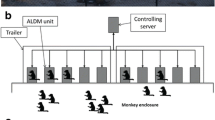Abstract
Fagot and Paleressompoulle (2009) published an automated learning device for monkeys (ALDM) to test the cognitive functions of nonhuman primates within their social groups, but the efficiency of the ALDM procedure with large groups remains unknown. In the present study, 10 ALDM systems were provided ad lib to a troop of 26 semi-free-ranging baboons that were initially naive with computerized testing. The test program taught baboons to solve two-alternative forced choice (2AFC) and matching-to-sample (MTS) tasks. A million trials were recorded for the group during a period of 85 days (Experiment 1). Their analysis shows that 75% of the baboons participated at high frequencies and quickly learned the 2AFC and MTS tasks. In Experiment 2, we compared the baboons’ behavior when the ADLM systems were either accessible or closed. ALDM reduced frequencies of object-directed behaviors, but had no overt consequence on social conflicts. In Experiment 3, we tested the process of the global or local attributes of visual stimuli in MTS-trained baboons in order to illustrate the efficiency of ALDM for behavioral studies requiring complex experimental designs. Altogether, the results of the present study validate the use of ALDM to efficiently test monkeys in large social groups. ALDM has a strong potential for a variety of scientific disciplines, including for biomedical research. Supplemental materials for this article may be downloaded from http://brm.psychonomic-journals.org/content/supplemental.
Similar content being viewed by others
References
Altmann, J. (1974). Observational study of behavior: Sampling methods. Behaviour, 49, 227–267. doi:10.1163/156853974X00534
Andrews, M. W., & Rosenblum, L. A. (1994). Automated recording of individual performance and hand preference during joystick-task acquisition in group living bonnet macaques (Macaca radiata). Journal of Comparative Psychology, 108, 358–362. doi:10.1037/0735-7036.108.4.358
Deruelle, C., & Fagot, J. (1998). Visual search for global/local stimulus features in humans and baboons. Psychonomic Bulletin & Review, 5, 476–481.
Dréa, C. M. (2006). Studying primate learning in group contexts: Tests of social foraging, response to novelty, and cooperative problem solving. Methods, 38, 162–177. doi:10.1016/j.ymeth.2005.12.001
Dréa, C. M., & Wallen, K. (1999). Low-status monkeys “play dumb” when learning in mixed social groups. Proceedings of the National Academy of Sciences, 96, 12965–12969.
Evans, T. A., Beran, M. J., Chan, B., Klein, E. D., & Menzel, C. R. (2008). An efficient computerized testing method for the capuchin monkey (Cebus apella): Adaptation of the LRC-CTS to a socially housed nonhuman primate species. Behavior Research Methods, 40, 590–596. doi:10.3758/BRM.40.2.590
Fagot, J., & Barbet, I. (2006). Grouping and segmentation of visual objects in baboons (Papio Papio) and humans (Homo sapiens). In E. Wasserman & T. R. Zentall, (Eds.), Comparative cognition: Experimental explorations of animal intelligence (pp. 15–28). New York: Oxford University Press.
Fagot, J., Bonté, E., & Parron, C. (2009). Concept of uprightness in baboons: Assessment with pictures of realistic scenes. Animal Cognition, 12, 369–379. doi:10.1007/s10071-008-0196-6
Fagot, J., & Cook, R. (2006). Evidence for large long-term memory capacities in baboons and pigeons and its implications for learning and the evolution of cognition. Proceedings of the National Academy of Sciences, 103, 17564–17567. doi:10.1073/pnas.0605184103
Fagot, J., & Deruelle, C. (1997). Processing of global and local visual information and hemispheric specialization in humans (Homo sapiens) and baboons (Papio papio). Journal of Experimental Psychology: Human Perception & Performance, 23, 429–442. doi:10.1037/0096-1523.23.2.429
Fagot, J., & Paleressompoulle, D. (2009). Automatic testing of cognitive performance in baboons maintained in social groups. Behavior Research Methods, 41, 396–404. doi:10.3758/BRM.41.2.396
Fagot, J., & Parron, C. (2010). Relational matching in baboons (Papio papio) with reduced grouping requirements. Journal of Experimental Psychology: Animal Behavior Processes, 36, 184–193.
Gimmig, D., Huguet, P., Caverni, J.-P., & Cury, F. (2006). Choking under pressure and working memory capacity: When performance pressure reduces fluid intelligence. Psychonomic Bulletin & Review, 13, 1005–1010.
Itani, J. (1958). On the acquisition and propagation of a new food habit in the natural group of the Japanese monkeys at Takasakiyama. Primates, 1, 84–98. doi:10.1007/BF01813697
Jürgens, U., & Hage, S. R. (2006). Telemetric recording of neuronal activity. Methods, 38, 195–2001. doi:10.1016/j.ymeth.2005.08.005
Navon, D. (1977). Forest before trees: The precedence of global features in visual perception. Cognitive Psychology, 9, 353–383. doi:10.1016/0010-0285(77)90012-3
Pallaud, B., & Lepoivre, H. (1985). Apprentissage d’inversion dans une situation de discrimination spatiale par un groupe de babouins: Interactions entre facteurs cognitifs et sociaux. Cahiers de Psychologie Cognitive, 5, 527–551.
Parron, C., & Fagot, J. (in press). First-and second-order configural sensitivity for greeble stimuli in baboons. Learning & Behavior.
Tomasello, M., & Call, J. (1997). Primate cognition. New York: Oxford University Press.
Toxopeus, I. B. (2004). Testing cognitive performance of socially housed monkeys: Possibilities and limitations of the study of social influences on age-related cognitive decline. Unpublished doctoral dissertation, Utrecht University. Available at http://igiturarchive.library.uu.nl/ dissertations/2004-1118-121020/index.htm.
Author information
Authors and Affiliations
Corresponding author
Additional information
J.F. contributed the development of the ADLM test systems, data collection, data analysis, and writing. E.B. contributed data collection and data analysis. This project was supported by the CNRS life science department and a grant (Project Ethique, Volet Recherches Exploratoires, 2008) from the Conseil Régional Provence-Alpes-Côtes d’Azur. Guy Dubreuil, Georges Di-Grandi, Sebastien Guiol, Jean-Christophe Marin, and Dany Paleressompoulle are acknowledged for technical supports. E.B. was supported by a PHD grant from the Conseil Régional Provence-Alpes-Côtes d’Azur. This research was approved by the Comité d’Éthique de Marseille Pour l’Expérimentation Animale.
Electronic supplementary material
Rights and permissions
About this article
Cite this article
Fagot, J., Bonté, E. Automated testing of cognitive performance in monkeys: Use of a battery of computerized test systems by a troop of semi-free-ranging baboons (Papio papio). Behavior Research Methods 42, 507–516 (2010). https://doi.org/10.3758/BRM.42.2.507
Received:
Accepted:
Published:
Issue Date:
DOI: https://doi.org/10.3758/BRM.42.2.507




